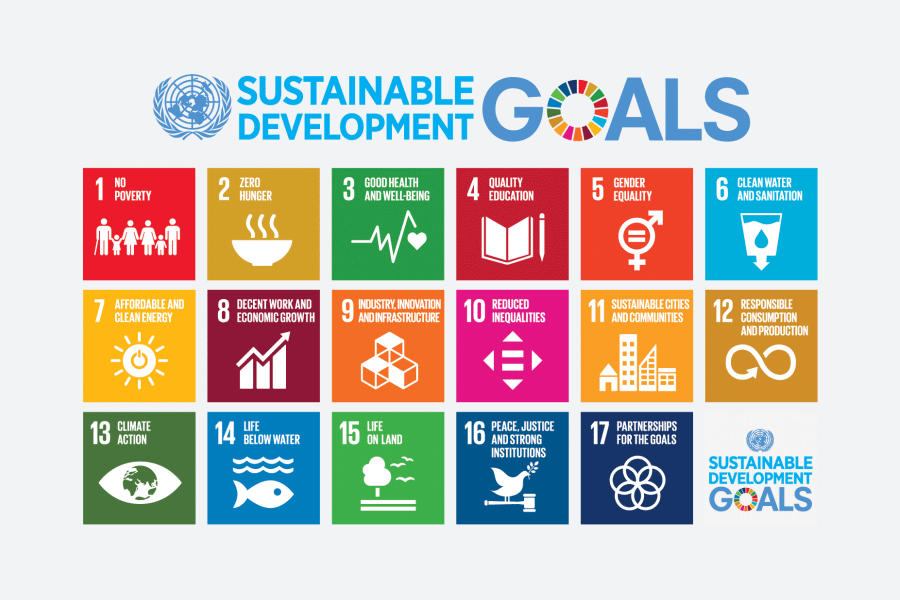Responsible Business Rankings
India’s Top Companies for
Sustainability and CSR 2021
India’s Top Companies and the SDGs
During 2017 UN Sustainable Development Summit, members from 193 countries of the United Nations collaboratively committed to adopting Sustainable Development Goals (SDGs, also known as Global Goals). The countries committed themselves to meet the 2030 agenda for sustainable development. The 17 SDGs and 169 interlinked targets within these range from ending poverty to stemming climate change. They provide a pathway for a sustainable and more prosperous world.
Since the Sustainable Development Goals have to be implemented by 2030, it requires an immense effort not only from the government but also businesses. The Indian Government is already using SDGs as a roadmap for formulating national policies and regulations. It is incumbent upon corporations to complement these actions.

Reporting of SDGs is a three-step process involving (i) develop priority SDG targets; (ii) measure and analyse; and, (iii) report, integrate and implement change.

Source: Integrating the SDGs into Corporate Reporting: A Practical Guide, GRI and UN Global Compact, 2018
| SDGs | Description | DG Mapped | Our mapping |
|---|---|---|---|
| SDG 1 | No Poverty | 71% | 53% |
| SDG 2 | Zero Hunger | 60% | 20% |
| SDG 3 | Good health & well being | 89% | 32% |
| SDG 4 | Quality Education | 88% | 46% |
| SDG 5 | Gender equality | 92% | 42% |
| SDG 6 | Clean water & sanitation | 88% | 44% |
| SDG 7 | Affordable & Clean energy | 81% | 35% |
| SDG 8 | Decent work and Economic growth | 91% | 66% |
| SDG 9 | Industry, innovation & infrastructure | 72% | 57% |
| SDG 10 | Reduce inequalities | 59% | 31% |
| SDG 11 | Sustainable cities & communities | 64% | 21% |
| SDG 12 | Responsible consumption & production | 81% | 43% |
| SDG 13 | Climate action | 88% | 55% |
| SDG 14 | Life below water | 28% | 3% |
| SDG 15 | Life on land | 53% | 43% |
| SDG 16 | Peace, Justice, and strong institutions | 39% | 46% |
| SDG 17 | Partnerships to achieve the goals | 66% | 43% |
Our study indicates that around 80% of our top 100 companies incorporate SDGs into their responsible business actions. All the top 25 companies map their business goals with SDGs. The leading sectors are IT and Telecom where 75% and more companies have mapped their goals with SDGs and the laggards are Other Industrials.
On an average, companies map 12 SDGs with a low of 2 and a maximum of 17. Of the companies that mapped their SDG goals, 88% were in the private sector and 68% were manufacturing companies. This clearly establishes that private companies are leading in the focus on SDG implementation.
In terms of focus, the SDG 5 (gender equality), SDG 8 (decent work), SDG 3 (good health & well-being), SDG4(quality education), (SDG 13 (Climate action), SDG (clean water and sanitation) occupy the top position with over 85% of the companies reporting them. On the other hand, SDG 14 (Life below water was mapped by the least number of companies – 28%. This is significantly in-line with our consistent finding based on CSR spending that companies tend to invest in education, healthcare, and environment in their CSR programmes.
We also attempted to map our scoring to the actions of top companies with the SDGs. The prominent SDGs were SDG 8 (decent work and economic growth), SDG 9 (industry, innovation and infrastructure) SDG 13 (climate action) and with over 55% of the companies indicating it as an action item. Other important ones were SDG 1 (No Poverty), 6 (clean water and sanitation) and 16 (peace, justice and strong institutions), and, SDG 4 (quality education). Across companies focused on SDG 5,4,6,3, and 8.
